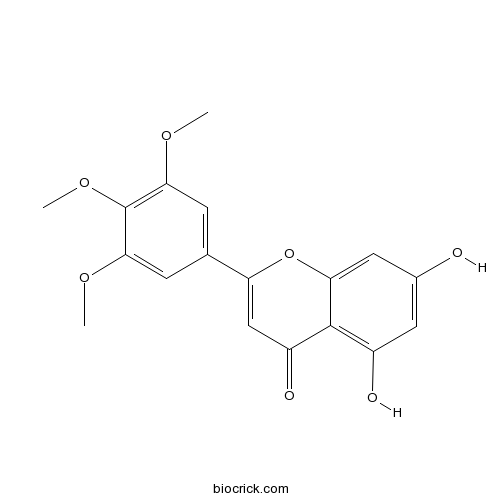5,7-Dihydroxy-3',4',5'-trimethoxyflavoneCAS# 18103-42-9 |

Quality Control & MSDS
3D structure
Package In Stock
Number of papers citing our products

| Cas No. | 18103-42-9 | SDF | Download SDF |
| PubChem ID | 5379265 | Appearance | Powder |
| Formula | C18H16O7 | M.Wt | 344.32 |
| Type of Compound | Flavonoids | Storage | Desiccate at -20°C |
| Solubility | Soluble in Chloroform,Dichloromethane,Ethyl Acetate,DMSO,Acetone,etc. | ||
| Chemical Name | 5,7-dihydroxy-2-(3,4,5-trimethoxyphenyl)chromen-4-one | ||
| SMILES | COC1=CC(=CC(=C1OC)OC)C2=CC(=O)C3=C(C=C(C=C3O2)O)O | ||
| Standard InChIKey | CPCPHNWWTJLXKQ-UHFFFAOYSA-N | ||
| Standard InChI | InChI=1S/C18H16O7/c1-22-15-4-9(5-16(23-2)18(15)24-3)13-8-12(21)17-11(20)6-10(19)7-14(17)25-13/h4-8,19-20H,1-3H3 | ||
| General tips | For obtaining a higher solubility , please warm the tube at 37 ℃ and shake it in the ultrasonic bath for a while.Stock solution can be stored below -20℃ for several months. We recommend that you prepare and use the solution on the same day. However, if the test schedule requires, the stock solutions can be prepared in advance, and the stock solution must be sealed and stored below -20℃. In general, the stock solution can be kept for several months. Before use, we recommend that you leave the vial at room temperature for at least an hour before opening it. |
||
| About Packaging | 1. The packaging of the product may be reversed during transportation, cause the high purity compounds to adhere to the neck or cap of the vial.Take the vail out of its packaging and shake gently until the compounds fall to the bottom of the vial. 2. For liquid products, please centrifuge at 500xg to gather the liquid to the bottom of the vial. 3. Try to avoid loss or contamination during the experiment. |
||
| Shipping Condition | Packaging according to customer requirements(5mg, 10mg, 20mg and more). Ship via FedEx, DHL, UPS, EMS or other couriers with RT, or blue ice upon request. | ||
| Description | 5,7-Dihydroxy-3',4',5'-trimethoxyflavone is a natural product from Centaurea scoparia. |
| In vitro | Cytotoxic activities of flavonoids from Centaurea scoparia.[Pubmed: 25114960 ]ScientificWorldJournal. 2014;2014:274207.
|

5,7-Dihydroxy-3',4',5'-trimethoxyflavone Dilution Calculator

5,7-Dihydroxy-3',4',5'-trimethoxyflavone Molarity Calculator
| 1 mg | 5 mg | 10 mg | 20 mg | 25 mg | |
| 1 mM | 2.9043 mL | 14.5214 mL | 29.0428 mL | 58.0855 mL | 72.6069 mL |
| 5 mM | 0.5809 mL | 2.9043 mL | 5.8086 mL | 11.6171 mL | 14.5214 mL |
| 10 mM | 0.2904 mL | 1.4521 mL | 2.9043 mL | 5.8086 mL | 7.2607 mL |
| 50 mM | 0.0581 mL | 0.2904 mL | 0.5809 mL | 1.1617 mL | 1.4521 mL |
| 100 mM | 0.029 mL | 0.1452 mL | 0.2904 mL | 0.5809 mL | 0.7261 mL |
| * Note: If you are in the process of experiment, it's necessary to make the dilution ratios of the samples. The dilution data above is only for reference. Normally, it's can get a better solubility within lower of Concentrations. | |||||

Calcutta University

University of Minnesota

University of Maryland School of Medicine

University of Illinois at Chicago

The Ohio State University

University of Zurich

Harvard University

Colorado State University

Auburn University

Yale University

Worcester Polytechnic Institute

Washington State University

Stanford University

University of Leipzig

Universidade da Beira Interior

The Institute of Cancer Research

Heidelberg University

University of Amsterdam

University of Auckland

TsingHua University

The University of Michigan

Miami University

DRURY University

Jilin University

Fudan University

Wuhan University

Sun Yat-sen University

Universite de Paris

Deemed University

Auckland University

The University of Tokyo

Korea University
- Corymbosin
Catalog No.:BCN6812
CAS No.:18103-41-8
- Curcumaromin C
Catalog No.:BCN7418
CAS No.:1810034-40-2
- Curcumaromin B
Catalog No.:BCN7419
CAS No.:1810034-39-9
- Curcumaromin A
Catalog No.:BCN7417
CAS No.:1810034-38-8
- 3-O-Caffeoylshikimic acid
Catalog No.:BCN7930
CAS No.:180981-12-8
- FTI 277 HCl
Catalog No.:BCC6395
CAS No.:180977-34-8
- Neuchromenin
Catalog No.:BCN7449
CAS No.:180964-26-5
- Spiramilactone B
Catalog No.:BCN1141
CAS No.:180961-65-3
- Jaceosidin
Catalog No.:BCN2529
CAS No.:18085-97-7
- 4-O-Caffeoylshikimic acid
Catalog No.:BCN7931
CAS No.:180842-65-3
- CHMFL-ABL-053
Catalog No.:BCC3988
CAS No.:1808287-83-3
- LG 100754
Catalog No.:BCC7786
CAS No.:180713-37-5
- Proflavine Hemisulfate
Catalog No.:BCC4707
CAS No.:1811-28-5
- 5-Hydroxy-4-methoxycanthin-6-one
Catalog No.:BCN1142
CAS No.:18110-86-6
- 4,5-Dimethoxycanthin-6-one
Catalog No.:BCN1143
CAS No.:18110-87-7
- Co 102862
Catalog No.:BCC7439
CAS No.:181144-66-1
- Almotriptan Malate
Catalog No.:BCC5045
CAS No.:181183-52-8
- DEL-22379
Catalog No.:BCC6521
CAS No.:181223-80-3
- Ginsenoside F4
Catalog No.:BCN2881
CAS No.:181225-33-2
- Taxuspine W
Catalog No.:BCN6937
CAS No.:181309-92-2
- Colutehydroquinone
Catalog No.:BCN8239
CAS No.:181311-16-0
- PD 160170
Catalog No.:BCC7284
CAS No.:181468-88-2
- Isonemerosin
Catalog No.:BCN6550
CAS No.:181524-79-8
- tert-Butyldimethylsilyl Chloride
Catalog No.:BCC2796
CAS No.:18162-48-6
Cytotoxic activities of flavonoids from Centaurea scoparia.[Pubmed:25114960]
ScientificWorldJournal. 2014;2014:274207.
Phytochemical studies on the ethanolic extract of the aerial parts of Centaurea scoparia led to the isolation of two new flavonoids, 3',4'-dihydroxy-(3'',4''-dihydro-3''-hydroxy-4''-acetoxy)-2'',2''-dimethylpyrano- (5'',6'':7,8)-flavone-3-O- beta -D-glucopyranoside (1) and 3,3',4'-trihydroxy-(3'',4''-dihydro-3'',4''-dihydroxy)-2'',2''-dimethylpyrano-(5' ',6'':7,8)-flavone (2), along with eight known flavonoids isolated for the first time from this plant, cynaroside (3), Apigetrin (4), centaureidin (5), oroxylin A (6), 5,7-dihydroxy-3',4',5'-trimethoxyflavone (7), atalantoflavone (8), 5-hydroxy-3',4',8-trimethoxy-2'',2''-dimethylpyrano (5'',6'':6,7)-flavone (9), and 3',4',5,8-tetramethoxy-2'',2''-dimethylpyrano (5'',6'':6,7)-flavone (10). The structures of the isolated compounds were elucidated by means of spectroscopic tools including 1D and 2D NMR, UV, IR, and mass spectroscopy. Cytotoxic activities of the isolated compounds were evaluated against human cervical carcinoma HeLa, human hepatocellular carcinoma HepG2, and human breast carcinoma MCF-7. Compound 2 was the most potent cytotoxic agent against HeLa cells with an IC50 0.079 muM.


